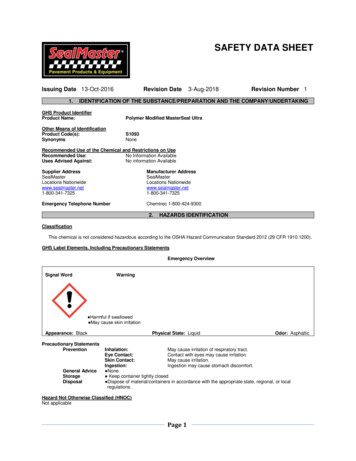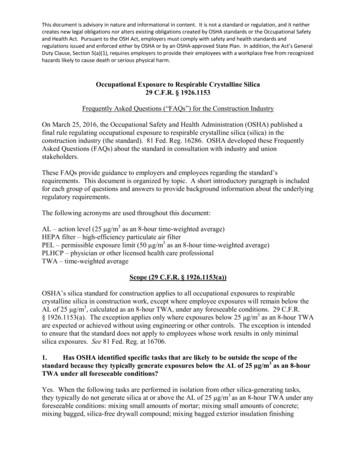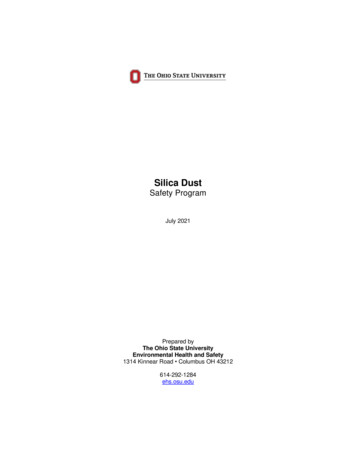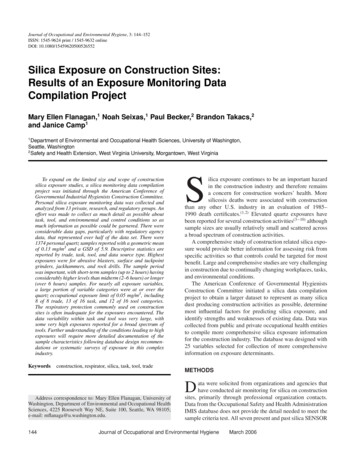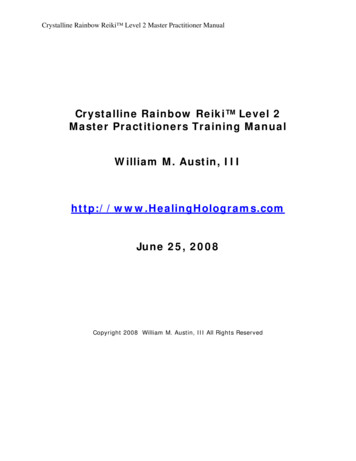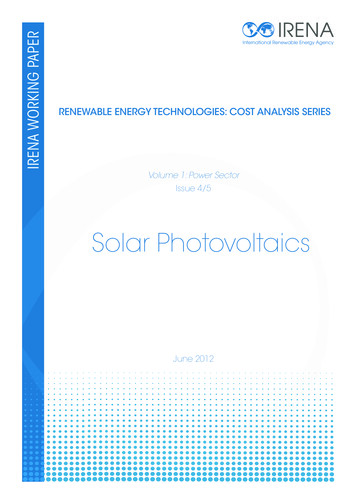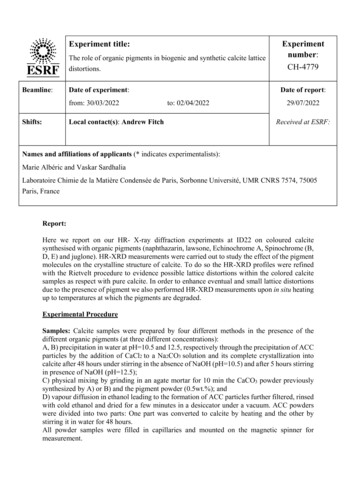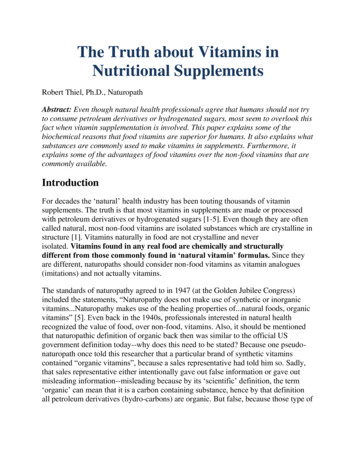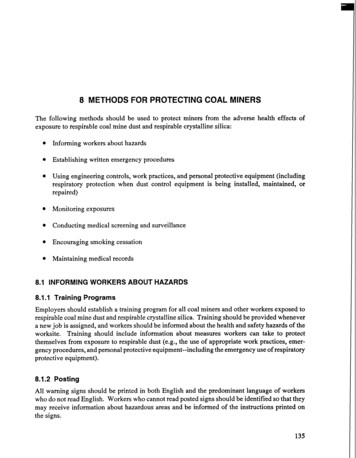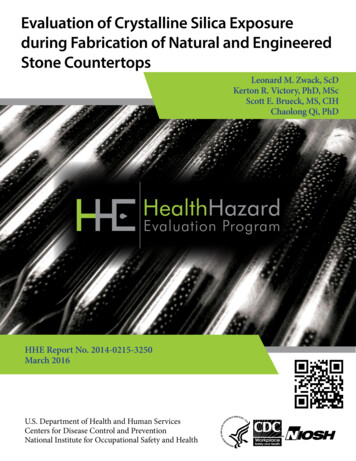
Transcription
Evaluation of Crystalline Silica Exposureduring Fabrication of Natural and EngineeredStone CountertopsLeonard M. Zwack, ScDKerton R. Victory, PhD, MScScott E. Brueck, MS, CIHChaolong Qi, PhDHHE Report No. 2014-0215-3250March 2016U.S. Department of Health and Human ServicesCenters for Disease Control and PreventionHealth Hazard Evaluation Report 2014-0215-3250NationalInstitute for Occupational Safety and HealthPage 1
ContentsHighlights.iAbbreviations. iiiIntroduction. 1Methods . 2Results. 3Discussion. 16Conclusions. 18Recommendations. 18Appendix A. 21Appendix B . 24References. 27Acknowledgements. 31The employer is required to post a copy of this report for 30 days at or near theworkplace(s) of affected employees. The employer must take steps to ensurethat the posted report is not altered, defaced, or covered by other material.The cover photo is a close-up image of sorbent tubes, which are used by the HHEProgram to measure airborne exposures. This photo is an artistic representation that maynot be related to this Health Hazard Evaluation. Photo by NIOSH.Page 2Health Hazard Evaluation Report 2014-0215-3250
Highlights of this EvaluationThe Texas Department of State Health Services asked the Health Hazard Evaluation Programfor help. They asked us to evaluate silica exposure in a manufacturing plant. The plant makesnatural and engineered stone countertops.What We Did We measured the amount of crystalline silica in the air. We looked at the ventilation systems to see if they were working properly. We observed work activities, production processes, and personal protective equipment use. We interviewed employees about their work and health. We reviewed results of employees’ previouslung function (spirometry) testing.What We Found Employees using grinders with diamond cupwheels had the highest exposures to crystallinesilica. Their exposures were above OccupationalSafety and Health Administration limits. Employees working in material handling andlamination were exposed to crystalline silicalevels below Occupational Safety and HealthAdministration limits. Their exposures, however,were above other recommended limits. We saw some employees incorrectly usingrespirators, safety glasses, and ear plugs.Although the company usedwet methods to control dust,we found overexposuresto respirable crystallinesilica. Exposures werehighest for employees usingpneumatic wet grinders withdiamond cup wheels. Werecommended the companyuse engineering controls todecrease exposures. We alsorecommended establishing amedical surveillance programfor employees exposed tocrystalline silica. We found several electrical safety hazards.These hazards included damaged electricalsystems or cords, improper use of electrical cords, and electrical cords lying in water onthe production floor. The company did not have an employee medical surveillance program for silica. We had concerns about the quality of the company’s spirometry tests. Because of theproblems, we could not interpret the results. Employees reported shortness of breath, chest pain, and loss of appetite. No employees reported a diagnosis of silicosis.What the Employer Can Do Use local exhaust ventilation for cutting, grinding, and polishing tasks. Do this inaddition to the wet methods already in use. Use a dust collector and enclosure thatHealth Hazard Evaluation Report 2014-0215-3250Page i
captures silica when using the pneumatic grinders with diamond cup wheels. Maintain the ventilation systems to ensure that they work properly, filters are changedregularly, and ductwork is not damaged or broken. Do a thorough electrical safety evaluation. Replace damaged electric cords and repairdamaged electrical systems. Ensure that the spirometry provider improves the quality of spirometry testing. Develop a medical surveillance program for employees exposed to silica. Review employee training on the proper use of personal protective equipment.What Employees Can Do Report work-related health concerns to the environmental health and safety manager.Also report concerns to your primary care physician. Wear personal protective equipment properly and consistently. Report safety violations or defective ventilation equipment immediately. Do not usefrayed or damaged electrical equipment. Take part in a company silica medical surveillance program.Page iiHealth Hazard Evaluation Report 2014-0215-3250
Abbreviationsµg/m3µg/sampleACGIH CFRCNCHVACNDNIOSHOELOSHAPELPPERELRPMTLV TWATxDSHSWEEL Micrograms per cubic meterMicrograms per sampleAmerican Conference of Governmental Industrial HygienistsCode of Federal RegulationsComputer numerical controlHeating, ventilation, and air-conditioningNondetectableNational Institute for Occupational Safety and HealthOccupational exposure limitOccupational Safety and Health AdministrationPermissible exposure limitPersonal protective equipmentRecommended exposure limitRevolutions per minuteThreshold limit valueTime-weighted averageTexas Department of State Health ServicesWorkplace environmental exposure levelHealth Hazard Evaluation Report 2014-0215-3250Page iii
This page left intentionally blankPage ivHealth Hazard Evaluation Report 2014-0215-3250
IntroductionIn May 2014, the Texas Department of State Health Services (TxDSHS) was notified of aworker with silicosis. He had been employed for approximately 10 years at an engineeredand natural stone countertop manufacturer as a polisher, laminator, and fabricator. To ourknowledge, this was the first reported case in North America of silicosis from occupationalexposure to quartz surfacing materials [CDC 2015]. It is well known that elevated crystallinesilica exposures are associated with stone work, specifically work with granite [NIOSH2002]. Granite has been reported to contain between 2% and 60% quartz, a type of crystallinesilica, by volume [Phillips et al. 2013]. In contrast, engineered stone can contain a higherpercentage of quartz; it can potentially contain over 90% crystalline silica [OSHA 2015a].Silicosis is an irreversible but preventable fibrotic lung disease caused by the deposition offine crystalline silica particles in the lungs. At least 1.7 million U.S. workers are exposed torespirable crystalline silica in a variety of industries and occupations including construction,sandblasting, and mining [NIOSH 2015].The TxDSHS requested assistance from the National Institute for Occupational Safety andHealth (NIOSH) Health Hazard Evaluation Program. They asked us to evaluate employees’exposures to airborne crystalline silica at the facility where the person with silicosis worked.We visited the facility in April 2015. During our visit we met with employer and employeerepresentatives, measured employees’ exposures to crystalline silica, and interviewedemployees about their work and health.BackgroundThe company began operations at the current location in 2004. The employer estimatedthat the facility was approximately 46,000 square feet, including a production shop floorand office space. At the time of our visit, the company had 59 employees at the location.Of these, 38 employees were classified as production employees and actively worked witheither natural or engineered stone. The company operated one 8–10 hour work shift per day,Monday through Friday. Most production employees worked between 6:30 a.m. and4:30 p.m. However, the material handling employees often worked at night to prepare stonefor the next day. Employees sometimes worked overtime, depending on production demands.The facility processed 100–160 pieces of stone per day, on average. The company estimatedthat approximately half of the materials they worked with were engineered stones and halfwere natural stone products, primarily granite.The countertop production process began on the west side of the facility. Here, employeescut large slabs of engineered or natural stone into smaller pieces using bridge saws and waterjet cutters. The bridge saws were equipped with a water spray to suppress dust during cuttingoperations. Material handlers brought the large pieces of stone to the machines via forklift.The type of machine used depended upon the type of cut required. Bridge saws made straightcuts, and water jet cutters made both straight and radial cuts. The cut stone then went tocomputer numerical control (CNC) machines for edging and profiling. Other large machines,such as the Comandulli machines, automatically polished the edges of the stone. All of thesemachines were equipped with a water spray to suppress dust during their operation. TheHealth Hazard Evaluation Report 2014-0215-3250Page 1
process ended in the final polishing and quality control area. Employees here used hand toolsequipped with a water spray to manually polish and grind the edges. Some employees usedpneumatic wet polishers with resin bonded polishing discs operating at 4,500 revolutionsper minute (RPM). Other employees used pneumatic wet grinders with diamond cupwheels operating at 7,000 RPM. Other employees did final quality control checks. Finishedcountertops were loaded onto carts and stored at the eastern side of the facility. Installationcontractors waited at the east end of the facility to pick up finished countertops.Other production jobs at the facility included lamination, in which employees wet cutthin strips of stone with a circular saw. These thin strips of stone were then glued to largercountertop pieces to form countertop edges. Some employees worked on the vanity line ofcountertops. Their primary job was to glue a sink into a countertop and then place it in a boxfor shipping.MethodsOur primary objectives were to evaluate employees’ exposures to respirable crystalline silicaand possible health effects. Our work involved (1) air sampling for respirable crystallinesilica, (2) evaluating the ventilation systems, (3) observing work practices, (4) reviewingcompany safety and health records, (5) reviewing spirometry results from the company’sprovider, and (6) holding confidential medical interviews with employees.Air Sampling for Respirable Crystalline SilicaWe collected full-shift personal air samples for respirable crystalline silica for 19 employeeson April 7, 2015, and for 17 employees on April 8, 2015. Additionally, we collected shortduration task-based personal air samples for respirable crystalline silica on employeespolishing stone and on employees using the grinders. We collected 11 task-based air sampleson April 7, 2015, and 17 task-based air samples on April 8, 2015. All of the task-basedsamples were collected for a minimum of 24 minutes. For each task-based air sample, thecorresponding worker’s activity during sampling was noted along with the type of stone theyworked with. We collected two representative bulk dust samples in the stone grinding andpolishing area.We collected the full-shift personal air samples using an aluminum SKC cyclone at a flowrate of 2.5 liters per minute. We collected the task-based personal air samples using a BGImodel GK2.69 cyclone at a flow rate of 4.2 liters per minute. The air samples were collectedand analyzed for respirable particulates according to NIOSH Method 0600 [NIOSH 2016].The limit of detection was 50 micrograms per sample (µg/sample). The limit of quantitationwas 160 µg/sample. The air samples and bulk samples were also analyzed for three formsof respirable crystalline silica (quartz, cristobalite, and tridymite) using x-ray diffractionaccording to NIOSH Method 7500 [NIOSH 2016]. The limits of detection were as follows:quartz, 5 µg/sample; cristobalite, 5 µg/sample; and tridymite, 10 µg/sample. The limits ofquantitation were as follows: quartz, 17 µg/sample; cristobalite, 17 µg/sample; and tridymite,33 µg/sample.Page 2Health Hazard Evaluation Report 2014-0215-3250
Ventilation System EvaluationWe visually inspected the air-handling unit on a mezzanine inside the production floor andexhaust fans throughout the facility. We also inspected the accessible ductwork for damage.In addition, using thin paper strips, we evaluated pressurization of the production floor withrespect to the adjacent office area.Review of Company Safety and Health RecordsWe reviewed two industrial hygiene reports the company provided. The reports includedrespirable crystalline silica sampling results collected by an industrial hygiene consultant inApril and May 2014. We also reviewed the company’s written respiratory protection program.We reviewed the Occupational Safety and Health Administration (OSHA) Form 300 Logof Work-Related Injuries and Illnesses for the years 2009–2014. As specified by OSHA,work-related injuries and illnesses are categorized into six groups: injuries, skin disorders,respiratory conditions, poisoning, hearing loss, and other [OSHA 2014]. Althoughrecommended by OSHA and NIOSH for silica exposed employees, the company had nomedical surveillance program [OSHA 2015a]. We noted that the program for respiratorclearance involved spirometry, but not the medical testing and follow-up recommended forsurveillance purposes.Review of Spirometry Test ResultsThe company provided spirometry for respirator clearance for its employees. Spirometrytests measure how much (volume) and how fast (flow) a person can move air into and outof your lungs. During our site visit, we requested all spirometry reports for current andformer employees. We received copies of spirometry results for testing completed onOctober 6–7, 2014. According to the spirometry provider, this was the first time that theyconducted testing on employees at this facility.Confidential Medical InterviewsWe invited all 58 employees working in the production and office areas on the dates of ourvisit to participate in confidential medical interviews. These interviews were conducted inEnglish or Spanish with assistance from public health interpreters. We discussed workplaceexposure and work history, medical history, use of personal protective equipment (PPE) atwork, and work practices.ResultsAir Sampling for Respirable Crystalline SilicaFull-shift Personal Air Sample ResultsEmployees used wet methods throughout the facility. Stone cutting and polishing hand toolsor saws were equipped with a water spray to help control dust generated by the tool (FigureHealth Hazard Evaluation Report 2014-0215-3250Page 3
1). The water lines connected to the hand tools were equipped with a control knob thatallowed the user to adjust the amount of water flowing to the tool. Some employees usedhigher water flow rates than others. We saw no dry cutting in the facility.Figure 1. Photo of a pneumatic wet grinder equipped with a diamond cup wheel and a water sprayused in the polishing area. Photo by NIOSH.Employees and management reported that they typically work with both natural andengineered stone over the course of a normal day. Throughout the work shifts we observed,each employee worked with engineered and natural stones. The time spent working witheach type of stone varied on the basis of customer orders and production demands. For thefull-shift air samples, we were not able to track and document the time spent working witheach type of stone. However, for the short-term, task-based samples, we documented whetheremployees worked with granite, engineered quartz, or both during the sample period.Table A1 in Appendix A shows detailed full-shift time-weighted average (TWA) personal airsampling results. The bolded values in these tables show where silica exposures were at orabove an occupational exposure limit (OEL). The OSHA permissible exposure limit (PEL)varies based on the percent quartz in each respirable dust sample, as discussed in AppendixB. The NIOSH and American Conference of Governmental Industrial Hygienists (ACGIH )OELs for respirable crystalline silica do not vary on the basis of the percent quartz. Whenemployees worked longer than an 8-hour work shift, we adjusted the ACGIH threshold limitvalue (TLV ) according to procedures recommended by Brief and Scala [1975]. The NIOSHlimit is not adjusted for extended work shifts and represents exposures up to a 10-hourworkday during a 40-hour workweek.Page 4Health Hazard Evaluation Report 2014-0215-3250
Over both days of sampling, the percentage of quartz in the respirable dust of the full-shift airsamples ranged from nondetectable (ND) to 52% (Table A1). We collected two bulk dust samplesfrom the areas near the work benches in the manual polishing area. One contained 48% quartz andone 70%. No cristobalite or tridymite were detected in any of the bulk or air samples.Table 1. Number of respirable dust and crystalline silica samples at or above any OEL overtwo days of samplingJob titleNumber ofsamples collectedNumber of samplesabove any OELOffice area employee20Material handler31Quality control/finishing10Vanity20CNC operator40Laminator21Bridge saw30Water jet cutter30Comandulli Omega operator30Comandulli Synthesis operator20Polisher - resin bonded disc50Grinder - diamond cup wheel44Computer-aided design department10Maintenance10**The air sample for the maintenance employee contained excessive visible debris on theair sampling filter. The employee had limited exposure to airborne silica during his work activities.The sampling result is not likely representative of the employee’s actual exposure.Table 1 presents summary results showing the number of crystalline silica or respirabledust samples at or above any OEL, over both days of sampling. Overall, the full-shift TWArespirable dust exposures ranged from ND to 380 micrograms per cubic meter (µg/m3),while the respirable crystalline silica exposures ranged from ND to 140 µg/m3. For bothsampling days, the full-shift exposures of the employees using the pneumatic wet grinderswith diamond cup wheels during the final polishing stage of production were all at or abovethe OSHA PEL, the NIOSH recommended exposure limit (REL), and the ACGIH TLVfor crystalline silica. In contrast, none of the other production employees we sampled hadexposures at or above the OSHA PEL for respirable dust containing crystalline silica. Thisincluded the pneumatic polishers with a resin bonded disc.Health Hazard Evaluation Report 2014-0215-3250Page 5
The polishers and grinders used similar-looking hand tools, with the major differences beingthe type of disc that was used and the speed at which they were run. The polishers used resinbonded discs that ran at about 4,500 RPM, while the grinders used diamond cup wheels thatran at about 7,000 RPM. Figure 2 depicts a worker using one of the hand polishing tools.Figure 2. Employee using a hand polishing tool outfitted with a water spray. Photo by NIOSH.Aside from the employee using the hand grinders equipped with diamond cup wheels, noother employees had an exposure to respirable dust containing crystalline silica above theOSHA PEL or to crystalline silica above the NIOSH REL. However, other employees on theproduction floor had exposures to crystalline silica above the ACGIH TLV. On the first dayof sampling, the laminator’s exposure was above the ACGIH limit of 25 µg/m3. Laminators’exposures to silica likely occur during their use of saws to cut small strips of stone orduring their use of hand-held grinding and polishing tools (Figure 3). On the second day ofsampling, the material handler was exposed to a crystalline silica concentration above theadjusted ACGIH limit of 13 µg/m3 for a 12-hour shift. During the second day of sampling,a CNC operator, a Comandulli Omega operator, and a laminator all had exposures close to,but slightly below, the adjusted ACGIH TLVs. None of the other employees monitored wereexposed above any of the OELs for silica. Employees working in the adjacent office areasdid not have detectable exposure to respirable dust containing crystalline silica or respirablecrystalline silica.Page 6Health Hazard Evaluation Report 2014-0215-3250
Figure 3. Photo of a lamination employee making a cut with a miter saw. Photo by NIOSH.Task-based Air Sampling ResultsTable A2 in Appendix A reports the TWA respirable dust concentrations and the TWArespirable crystalline silica concentrations for short-term, task-based breathing zone airsamples. There are no short-term OELs for silica. These samples provided information aboutthe employee’s exposure to crystalline silica while performing specific tasks.Overall, respirable dust exposures during the short-term polishing and grinding tasks ranged fromND to 430 µg/m3 for the polishers, and from 200 to 550 µg/m3 for the two grinders. Respirablecrystalline silica exposures during the short-term polishing and grinding tasks ranged from ND to140 µg/m3 for the polishers, and from 50 to 140 µg/m3 for the two grinders.Ventilation System EvaluationNo mechanical heating or cooling was provided to the main production floor by a heating,ventilation, and air-conditioning (HVAC) system. However, general exhaust ventilation ofthe production floor was provided by large exhaust fans in the roof of the building and largebay doors on the east end of the building. These doors were open at the time of our visit. Theemployer stated that the doors were typically open, except during the winter. None of thework processes used local exhaust ventilation.Two rooftop-mounted Trane air-handling units provided ducted supply air to the officespaces adjacent to the production floor. A Payne air-handling unit on a mezzanine inside theproduction floor and outside the conference room also served the office space. We observedstanding water and extensive rust and biological growth in the condensate drain pan for thePayne air-handling unit (Figure 4). We also observed that the unit was missing its air filterHealth Hazard Evaluation Report 2014-0215-3250Page 7
and that some of the flexible duct attached to the unit was torn (Figure 5). This unit was inthe production area, so openings in the flexible duct could allow crystalline silica or otherdusts from the production area to enter the office space. Employer representatives stated thatan HVAC contractor serviced these units, and that they were unsure how often the filterswere changed.Pressurization checks between the production floor and the adjoining office space indicatedthat the production floor was negatively pressurized with respect to the adjacent office area.This will help limit the amount of airborne crystalline silica or other dust entering the officespace when employees open the door to the production floor.Figure 4. Discolored standing water in the drain pan of the air-handling unit on the mezzanine. Photoby NIOSH.Figure 5. Torn flexible duct attached to the air-handling unit on the mezzanine. Photo by NIOSH.Page 8Health Hazard Evaluation Report 2014-0215-3250
Workplace Observations and Safety HazardsPersonal Protective Equipment UseEmployees in production areas were required to use respiratory protection, hearingprotection, eye protection, rubber safety shoes, nylon knitted work gloves with latex dippedpalms and fingers, and vinyl aprons. The employer provided uniforms to the employees at thebeginning of each day. A contractor laundered the uniforms offsite. We observed that not allemployees properly wore their safety glasses while on the production floor. We observed oneemployee wearing safety glasses on top of his head while using a hand polishing tool. Notall employees wore gloves while on the production floor, and some employees had cut offthe tips of their gloves. We also observed an employee wearing his insert-type foam hearingprotection sideways in his ear. Additionally, it appeared that some employees did not inserttheir hearing protection deeply enough into their ear canal.We observed that all employees wore respirators when entering the production floor asrequired by the company. Production employees wore elastomeric, half-face air-purifyingrespirators (3M model 7502). Most production employees used P100 particulate filtercartridges (3M model 7093) with their respirator; however, laminators used combinationP100 and organic vapor cartridges (3M model 60921). The respirator program administratorreported that employees changed P100 cartridges once per week and changed combinationcartridges at least once per month, but could change them more often if requested. Anemployee reported during informal discussions that he usually changed cartridges once eachweek. Employees who were not primarily working on the production floor, such as managersor office staff, donned N95 filtering facepiece respirators (3M model 8200 or ULine modelS-9632) prior to entering the production floor. In most instances, respirators were wornproperly. However, we observed the following instances of improper respirator use: Some employees wore the straps of N95 filtering facepiece respirators incorrectly, suchas wearing both straps around the base of the neck, using only one of the two straps, orcutting off one of the straps. Respirators only fit tightly and seal properly if both strapsare used correctly. Some employees or managers had facial hair that could interfere with the seal of therespirator to the face. We observed that employees or managers sometimes pulled the respirator away fromtheir face when speaking with other employees. This practice allows air contaminantsto be breathed in.Safety HazardsThe handle on the maintenance office door was broken, and the door would not close. Thisoffice was connected to the production floor, and the open door could allow airborne silica toenter the maintenance office (Figure 6). The maintenance supervisor used the office and didnot wear a respirator when inside.Health Hazard Evaluation Report 2014-0215-3250Page 9
Figure 6. View of broken door from inside of the maintenance room, looking out to the productionfloor. Photo by NIOSH.We observed that the pneumatic stone slab lifter attached to a half-ton overhead craneremained in a suspended position about 6 to 8 feet above the floor during times it was not inuse. Employees sometimes walked under the suspended slab lifting device (Figure 7).Figure 7. Slab lifter attached to overhead crane. Photo by NIOSH.Page 10Health Hazard Evaluation Report 2014-0215-3250
We observed an employee standing on the side of a forklift, which is an unsafe work practice,while the forklift operator lifted and removed large stone slabs from a semi-trailer. Theemployee was helping instruct the operator on positioning the forks and backing the slabs outof the trailer without damaging other slabs in the trailer.We noted several electrical safety hazards during our site visit, specifically: Electrical cords were lying in water (Figure 8). Electrical cords had damaged or torn insulation jackets. Some had been repaired usingelectrical tape (Figure 9), and others had exposed inner wires (Figure 10). Three long lengths of extension cords were daisy-chained (i.e., connected in series)from the production building to the outside stone slab storage area behind the building.We also observed extension cords daisy-chained to power strips. An electrical junction box attached to a Comandulli machine was severely damagedfrom oxidation and rust. The electrical power supply fittings were dangling loose fromthe junction box, exposing internal electrical wiring junction box connection points(Figure 11). A forklift operator drove over an extension cord that had been stretched acrossthe inclined loading dock in the back of the building. The cord was plugged intoan electrical outlet in the building and was connected to a series of daisy-chainedextension cords that were stretched across a field to a reciprocating saw being used tocut wooden support frames in the back of a semi-trailer. The expanded metal housing on the end of a Comandulli machine motor was corrodedand partially missing.Figure 8. Electrical cords in water. Photo by NIOSH.Health Hazard Evaluation Report 2014-0215-3250Page 11
Figure 9. Electrical cords with damaged or torn insulation jackets. Photo by NIOSH.Figure 10. Extension cord with damaged insulation jacket near the plug. Photo by NIOSH.Figure 11. Severely damaged electrical junction box at Comandulli machine. Photo by NIOSH.Page 12Health Hazard Evaluation Report 2014-0215-3250
Review of Company Safety and Health RecordsReview of Industrial Hygiene ReportsThe company provided us with two industrial hygiene reports. These reports detailedthe results of personal air sampling for respirable crystalline silica. In April 2014, aninsurance company representative did personal air sampling on four employees. None of theemployees’ 8-hour TWA exposures were greater than 50% of the OSHA PEL, and no sampleswere above the NIOSH REL of 50 µg/m3. However, three of the four personal sampleswere above the ACGIH TLV of 25 µg/m3. The employees overexposed to the TLV includedone working at the bridge saw, one using a Comandulli machine, and one doing countertopmanual fabrication. The type of tool used by the employee performing the manual fabricationtasks was not reported. The employee who was not overexposed was reported to be doingmaintenance tasks and working in the “filteration” [sic] room. While we did not observe anyoverexposures in our sampling for the bridge saw operators, one of the Comandulli operatorshad crystalline silica exposures just below the TLV. The results for the employee performingmanual fabrication are not directly comparable to our results, as we do not know what type oftool the employee was using.In May 2014,
HHE Report No. 2014-0215-3250. March 2016 Leonard M. Zwack, ScD. Kerton R. Victory, PhD, MSc . U.S. Department of Health and Human Services Centers for Disease Control and Prevention National Institute for Occupational Safety and Health. Page 2 ea aa vaai e 201402153250. Contents. Highlights . We found several electrical safety hazards .
